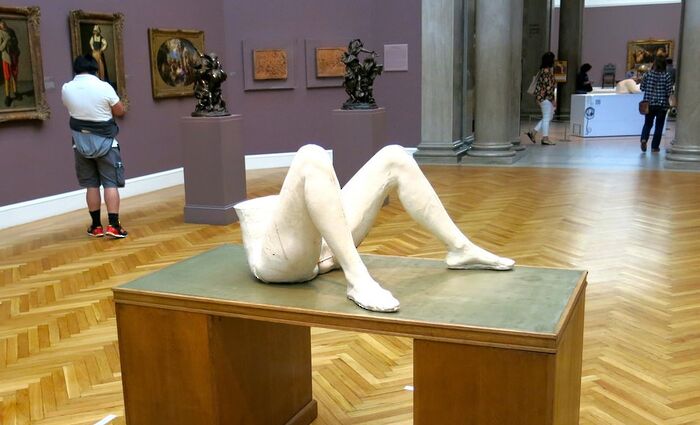Fighting AIDS through art: how Keith Haring pioneered LGBT+ visibility
Coinciding with the beginning of Pride Month, Zachary Myers discusses the work of one of the LGBT+ community’s greatest artists

Popular contemporary art forms have had a history of responding to both moments of political turmoil and the elements of the everyday life. Sexuality lies at the intersection of these two phenomena, always refracted through the prism of artistic creation. Few artists have engaged with sexuality in a more exciting and honest way than Keith Haring.
The height of Haring’s fame coincided with the height of the AIDS epidemic in the United States, a crisis that informed his art on a political and personal level. Haring was diagnosed with AIDS in 1988, dedicating the final years of his life to activism and the creation of art that generated awareness about the AIDS epidemic. In 1989, Haring established the Keith Haring Foundation to provide funding and imagery for AIDS organizations. His work acts as a constant reminder of the politics of sexuality, but despite its sombre subject matter manages to create spaces for joy. The configuration of his lively, unapologetically fun characters drawn in a simplistic pop style have a way of making us happy regardless of their political message. Haring reminds us that while our existence as members of the LGBT community is one that can never escape the grasp of politics, it is an existence that allows us to be cheerful (or, if you will, gay) despite this.
Haring refused to be caught in the deafening echo of the dead air surrounding AIDS, instead answering with a shout
AIDS was first discovered in the Unites States in 1981 and was originally diagnosed largely in communities of gay men. Throughout the 1980s the disease disproportionately affected the LGBT community, causing widespread panic in places like New York where Haring completed the majority of his work. The stigma surrounding it was only propagated by the Reagan administration’s relative silence and inaction regarding the issue. It was this silence that became the most dangerous aspect of the crisis, prompting Haring to respond with activism and art that gave the peoples affected by it a voice. Haring refused to be caught in the deafening echo of the dead air surrounding AIDS, instead answering with a shout.
Works like Silence=Death directly tackled this, appropriating the imagery of the pink triangle used by the Nazis to identify homosexuals and the motto and logo of the AIDS activist group ACT-UP. The startling juxtaposition of the black background and the centred bright pink triangle draws the eye from the margins of the drawing to the middle, highlighting the animated pop of colour. Pink, a colour that had developed associations of femininity and homosexuality, refuses to be hidden. Through colour alone Haring demands the recognition of sexuality amidst a political climate that would resign homosexuals to death and to silence. The layering of the silver figures that ‘veil’ the drawing creates incessant activity, despite its subject matter this drawing is flourishing with life. These lively cartoon-like characters are in constant motion, and are positioned in ways that they are seen to “see no evil, hear no evil, speak no evil.”

In his biting condemnation of the wilful ignorance of American society and government, he still manages to create a vision of excitement and joy. By bringing to the forefront the issues of sexuality in his work, Haring was able to break through the pervasive silence surrounding AIDS in favour of noise, resisting death in favour of life.
Other unashamedly political works such as Ignorance=Fear are similarly vibrant in their colour and action. The positioning of his dancing figures, communicated through simplistic use of line to suggest motion, lends the work a degree of not only vivacity, but also fun.
At the most basic level, Haring’s work is enjoyable to look at. His characters bop and move with a childlike purity, juxtaposed with the simplistic but powerful visual language of protest. Haring’s activism sidesteps the quicksand of pessimism in favour of the creation of the sensation of joy. While Haring has no qualms about the politicisation of homosexuality, he balances this with the innocence and vitality of dance. Without obscuring the message of his work, Haring reminds us that resistance can be an act of happiness.
Haring was a pioneer in developing visibility for the gay community, something that today we often take for granted. In this respect, his work has an especially poignant significance for me and for many people like me that come from countries where visibility is still a huge issue for the LGBT+ community. Coming from Bermuda, homosexuality has always been something hidden in the mist of public taboo. Haring’s work is a reminder for our times that we can no longer afford to hide, and why should we? If Haring’s work tells us anything, it is that we should make noise, that we should dance, and that we should live.
 Music / The pipes are calling: the life of a Cambridge Organ Scholar25 April 2025
Music / The pipes are calling: the life of a Cambridge Organ Scholar25 April 2025 News / Candidates clash over Chancellorship25 April 2025
News / Candidates clash over Chancellorship25 April 2025 Interviews / Dr Ally Louks on going viral for all the wrong reasons25 April 2025
Interviews / Dr Ally Louks on going viral for all the wrong reasons25 April 2025 Comment / Cambridge builds up the housing crisis25 April 2025
Comment / Cambridge builds up the housing crisis25 April 2025 Arts / Plays and playing truant: Stephen Fry’s Cambridge25 April 2025
Arts / Plays and playing truant: Stephen Fry’s Cambridge25 April 2025






